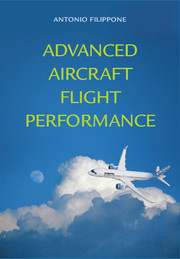Book contents
- Frontmatter
- Contents
- Tables
- Preface
- Nomenclature
- Technology Warning
- 1 Prolegomena
- 2 Aircraft Models
- 3 Weight and Balance Performance
- 4 Aerodynamic Performance
- 5 Engine Performance
- 6 Propeller Performance
- 7 Airplane Trim
- 8 Flight Envelopes
- 9 Take-Off and Field Performance
- 10 Climb Performance
- 11 Descent and Landing Performance
- 12 Cruise Performance
- 13 Manoeuvre Performance
- 14 Thermo-Structural Performance
- 15 Mission Analysis
- 16 Aircraft Noise: Noise Sources
- 17 Aircraft Noise: Propagation
- 18 Aircraft Noise: Flight Trajectories
- 19 Environmental Performance
- 20 Epilogue
- Appendix A Gulfstream G-550
- Appendix B Certified Aircraft Noise Data
- Appendix C Options for the FLIGHT Program
- Index
- References
10 - Climb Performance
Published online by Cambridge University Press: 05 January 2013
- Frontmatter
- Contents
- Tables
- Preface
- Nomenclature
- Technology Warning
- 1 Prolegomena
- 2 Aircraft Models
- 3 Weight and Balance Performance
- 4 Aerodynamic Performance
- 5 Engine Performance
- 6 Propeller Performance
- 7 Airplane Trim
- 8 Flight Envelopes
- 9 Take-Off and Field Performance
- 10 Climb Performance
- 11 Descent and Landing Performance
- 12 Cruise Performance
- 13 Manoeuvre Performance
- 14 Thermo-Structural Performance
- 15 Mission Analysis
- 16 Aircraft Noise: Noise Sources
- 17 Aircraft Noise: Propagation
- 18 Aircraft Noise: Flight Trajectories
- 19 Environmental Performance
- 20 Epilogue
- Appendix A Gulfstream G-550
- Appendix B Certified Aircraft Noise Data
- Appendix C Options for the FLIGHT Program
- Index
- References
Summary
Overview
The aircraft climb includes a variety of flight problems in which the airplane usually (not always) gains altitude. We define the general governing equations for flight in the vertical plane and thence some closed-form solutions for the propeller and jet airplane (§ 10.2). We then present the general problem of climb by a transport aircraft and show numerical solutions for both types of airplanes (§ 10.3), including the case of one engine inoperative (§ 10.3.6). The case of the turboprop aircraft is discussed in § 10.4. A powerful method for dealing with aircraft climb, particularly at transonic and supersonic Mach numbers, is the total energy approach (§ 10.5). There is a wide range of climb problems addressed with the energy methods. We report a few of these cases in § 10.6.
Accelerated climb problems are exclusively the domain of numerical solutions. Some of these methods are mathematically involved and will not be discussed in sufficient detail. The assumption of quasi steady flight is valid for many conventional aircraft.
KEY CONCEPTS: Closed-Form Solutions, Climb to Initial Altitude, Energy Method, Specific Excess Power, Optimal Climb, Climb Trajectories.
Introduction
There are two methods for solving climb problems: by solution of the differential equations that govern the motion of the centre of gravity and by the use of energy methods. There is a difference in the climb characteristics of propeller- and jet driven aircraft.
Information
- Type
- Chapter
- Information
- Advanced Aircraft Flight Performance , pp. 269 - 299Publisher: Cambridge University PressPrint publication year: 2012
